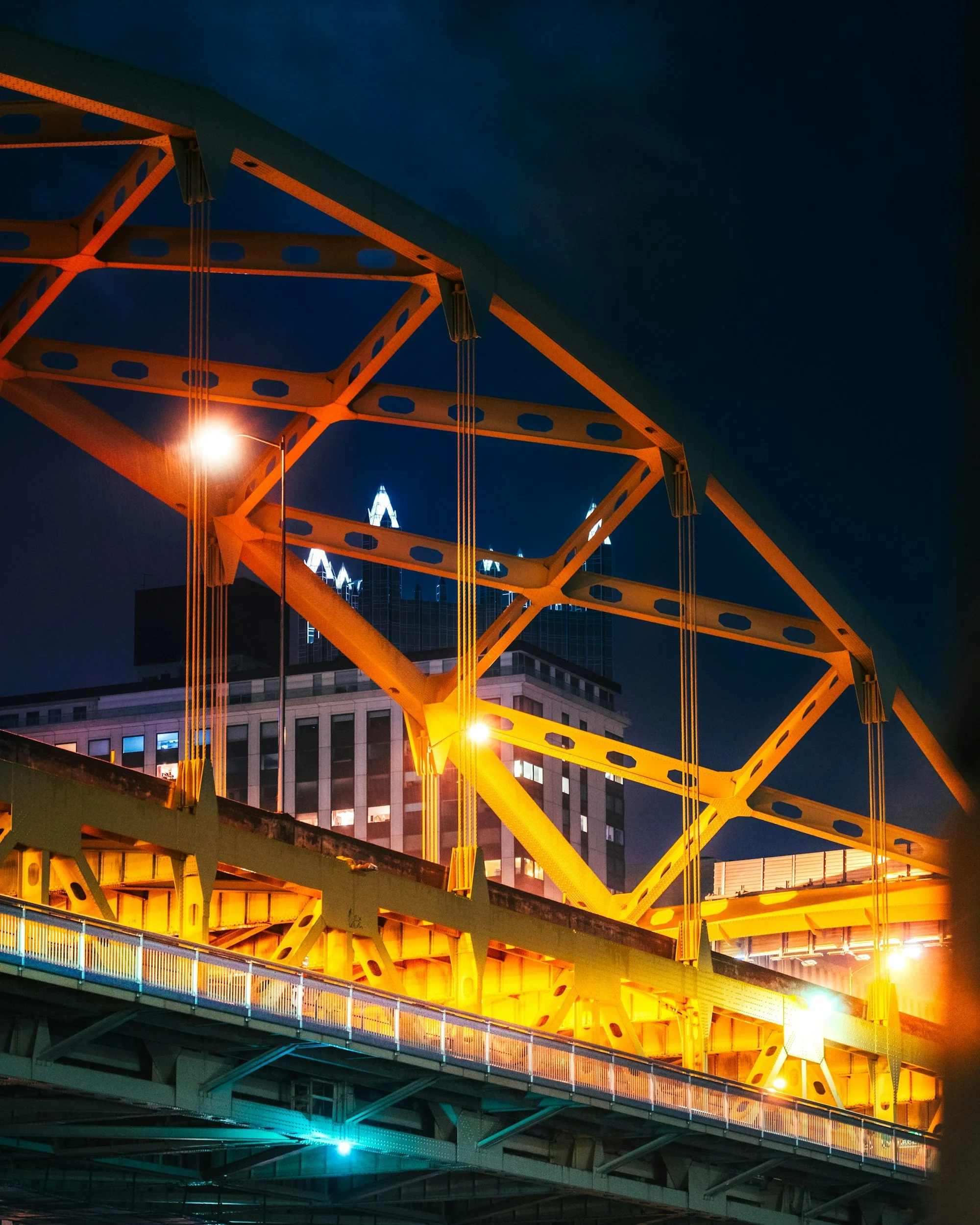The Ultimate Guide to Pittsburgh’s 10 Most Famous Bridges (Even If You’ve Never Heard of Them!)
Pittsburgh isn’t called “The City of Bridges” for nothing. With 446 bridges criss-crossing its three rivers and hilly neighborhoods, it actually has more bridges than any city in the world — yes, even Venice! These bridges aren’t just for getting from point A to B; they’re the lifelines that shaped Pittsburgh’s identity, connecting people, neighborhoods, and generations.
Whether you’re new to Pittsburgh or just curious about what makes these crossings so special, here’s a peek at the ten most famous bridges — including a bit of history, how to get there from our bungalow, and the must-do experiences around each one.
Roberto Clemente Bridge
Originally opened in 1928 as the Sixth Street Bridge, this bright yellow beauty was renamed in 1998 to honor Pittsburgh Pirates legend Roberto Clemente. It’s known for closing to cars on game days so fans can walk right over to PNC Park, adding to its lively vibe. From Doc’s Family Bungalow, it’s about a 15-minute drive via I-279 S straight into downtown. Once you’re there, catch a Pirates game, pop into the Andy Warhol Museum, or enjoy a riverside walk along the North Shore Riverwalk for awesome city views.
Andy Warhol Bridge
This sister bridge, originally the Seventh Street Bridge, opened in 1926 and was renamed for Pittsburgh-born pop artist Andy Warhol in 2005. The bright yellow span is part of the famous “Three Sisters,” a trio of nearly identical self-anchored suspension bridges. From Doc’s Family Bungalow, you’ll follow I-279 S and park downtown before strolling a few blocks to the bridge. Nearby, you can tour the Warhol Museum’s colorful exhibits, grab creative bites at Federal Galley, or snap photos of public art on the North Shore.
Rachel Carson Bridge
Opened in 1926 as the Ninth Street Bridge, this bridge was renamed to honor environmental pioneer Rachel Carson, who was born just outside Pittsburgh. With its graceful design and skyline views, it’s beloved by photographers and locals alike. Take I-279 S to Ninth Street, and you’ll arrive in about 15 minutes. While you're there, wander through the vibrant Strip District markets, grab a show at Benedum Center, or sip artisan coffee at De Fer Coffee & Tea.
Fort Pitt Bridge
This steel arch bridge opened in 1959 and is most famous for the dramatic entrance it offers when exiting the Fort Pitt Tunnel — that moment when the city skyline suddenly bursts into view feels straight out of a movie. From Doc’s Family Bungalow, take I-279 S to I-376 W through the tunnel, and you’ll be right there. After crossing, explore Point State Park’s fountain and Fort Pitt Museum, stroll or bike the Three Rivers Heritage Trail, and soak in the sweeping river views.
Fort Duquesne Bridge
Fort Duquesne Bridge
Completed in 1969 after being humorously dubbed the “Bridge to Nowhere” (it stood unfinished for years), this bridge now links downtown to the North Shore and is vital for game-day traffic and city explorers. You’ll get there from Doc’s Family Bungalow via I-279 S to Fort Duquesne Blvd. While nearby, visit the Carnegie Science Center for hands-on fun, try your luck at Rivers Casino, or hop aboard a Gateway Clipper river cruise for a unique look at the city from the water.
Smithfield Street Bridge
First built as a wooden bridge in 1818 and redesigned in 1883, this is the oldest steel bridge in the United States, known for its beautiful lenticular truss design and blue arches. From Doc’s Family Bungalow, drive I-279 S to Station Square parking. In the area, you can take the historic Monongahela Incline up to Mount Washington for jaw-dropping skyline views, dine at the elegant Grand Concourse, or wander around Station Square’s shops and riverside paths.
Smith Street Bridge
Birmingham Bridge
Opened in 1977, the Birmingham Bridge connects the South Side to Oakland and is widely used by students and hospital staff. Its double-arch design and striking modern look make it a recognizable piece of the cityscape. From Doc’s Family Bungalow, take I-279 S and follow signs toward Boulevard of the Allies and Birmingham Bridge. While there, explore the lively bars and restaurants along East Carson Street, check out SouthSide Works for shopping, or bike the river trails for a breezy adventure.
Liberty Bridge
This 1928 bridge links downtown Pittsburgh to the South Hills and was recently revitalized with major repairs. Its importance to commuters and its role in Pittsburgh’s growth are huge. From Bellevue, follow I-279 S to I-579 S, and you’ll cross the bridge into town. Near Liberty Bridge, you can explore Uptown’s hidden gems, catch a Penguins game or concert at PPG Paints Arena, and visit Duquesne University’s scenic campus.
16th Street Bridge (David McCullough Bridge)
Built in 1923 and renamed in 2013 for the beloved historian and Pittsburgh native David McCullough, this bridge links the Strip District to the North Side. Hop on I-279 S and exit at 16th Street. Nearby, dive into the Strip District’s bustling markets and food scene, have brunch at local favorite Pamela’s Diner, or tour Wigle Whiskey for a fun and flavorful experience.
McKees Rocks Bridge
Opened in 1931, the McKees Rocks Bridge spans the Ohio River and connects Pittsburgh with the historic McKees Rocks neighborhood. From Doc’s Family Bungalow, it’s a quick drive via I-279 S to PA-65 N, then follow signs for McKees Rocks. Once there, catch a live show at the beautifully restored Roxian Theatre, grab a plate of pierogies at Pierogies Plus, or take a stroll to explore the area's industrial charm and hidden history.
Your Next Pittsburgh Adventure Awaits
Now that you know a bit about these iconic bridges, why not plan a day (or ten) to explore them? Each bridge is more than a crossing — it’s a gateway to local food, art, history, and views you won’t find anywhere else.





